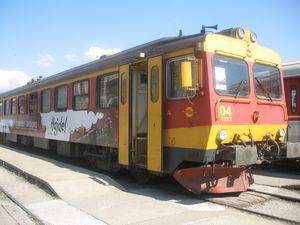Advertisement
Published: October 3rd 2011
Video Playlist: 1:
Patriarchate 49 secs
1 additional video(s) currently being processed 
 Hajde!
Hajde!
Meaning "Come" in Albanian - the title of our tour.One of our - and when I say our, I mean Jane, Deb, Cate, Krista, and I - goals this year is to see more of Kosova since we spent much of our vacation time traveling outside of the country in which we are actually living. So when we heard that a cultural herritage group was running tours to Pejë - a city that we have been through on the way to the mountains - every Saturday and Sunday for a month, we knew we had to go, especially after we found out that the whole trip - from train ride to tour around Pejë was free! So early Sunday morning, we embarked on our journey to Pejë, not quite sure what to expect. But we were pleasantly surprised by the entire day.
When we arrived at the Pejë train station, treats were waiting for us, and then we promptly boarded a bus to our first destination which happened to be a Hamam, or public bath. The bath had been built in the 14th century but was destroyed several times, most recently in 1999 and is now under reconstruction. We were able to walk through both the men's and women's sides
and even see some of the small cisterns that they would have scooped water out of to bathe with. We then wandered through what is left of the old town, where the silversmiths, carpenters, and other handcraft professions would have, and some still do, have their shops. We also stopped by a mosque, though the man who had the key wasn't there to let us in. Our last stop in downtown Pejë was the Ethnological Center. The most interesting thing about this building was that it was dismantled, carried from its original position, and reassembled at its present location. The reason for this was that when Kosova was part of Yugoslavia a building was to be built over it, so concerned citizens who wanted to preserve their history and culture moved the entire building. Old Illyrian ruins were covered up by another such building - it seems that they were trying to repress the native culture. Inside, traditional clothing, jewelry, and instruments were on display.
Next, we headed out of town to White Drin Spring for lunch and to explore a bit of the natural beauty of Kosova. After an excellent trout lunch, Cate and I wandered up towards the

 Hamam
Hamam
Inside the main men's steam room of the hamamspring. As soon as we left the confines of the restaurant it seemed as if we had left civilization behind and had been wandering through the woods for hours. You couldn't hear the slightest sound from the restaurant, only the musical sound of falling and rushing water.
Then we were back on the bus and headed to a Catholic church and Patriarchate complex. The Catholic church, the Church of St. Katherine, is home to 14 nuns who care for the elderly and are dedicated to improving the lives of those in their church community, which consists of 230 families, and beyond. The Patriarchate complex, however, was my favorite part of the tour. The Patriarchate is a Serbian enclave that houses a very, very old Orthodox church, where all the Serbian Patriarchs are crowned, and a community of nuns. One of the nuns, a tiny old lady, gave us a tour and a very progressive message for the place in which she lives. She told us that we were all created in God's image and are all his children, no matter if we were Jewish, Muslim, or Christian. I was amazed that she could give such a message, seeing what she

 Cistern
Cistern
Where women would have scooped water out of to take a bath.has probably seen in her lifetime and knowing the tensions that are still so high strung between her country and Kosova. The church itself was a work of art. Frescoes, depicting the calendar of the saints, the life of Jesus, and the stories of the apostles. They were magnificent to say the least.
After the last of our tour trailed out, we boarded the bus and headed back to the train station for what seemed like a very long ride back to Prishtina and another work week.
Advertisement
Tot: 0.31s; Tpl: 0.012s; cc: 15; qc: 78; dbt: 0.1153s; 1; m:domysql w:travelblog (10.17.0.13); sld: 1;
; mem: 1.2mb

 Hajde!
Hajde!
 Hamam
Hamam
 Cistern
Cistern












